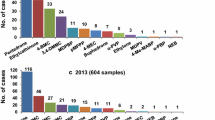Abstract
Purpose
An amphetamine-type new psychoactive substance was identified in a fine white yellowish powder from a seizure control held in Spain in July 2017.
Methods
Seized sample was deeply characterized by standard and high-performance analytical techniques like attenuated total reflectance-Fourier-transform infrared spectroscopy, gas chromatography–electron ionization–mass spectrometry, high-resolution mass spectrometry, nuclear magnetic resonance spectroscopy, and ion mobility spectrometry.
Results
The seized sample was identified as 3-fluoroethamphetamine hydrochloride. To our knowledge this is the first report dealing with identification and characterization of 3-fluoroethamphetamine.
Conclusions
Characterization data were compiled in order to provide the scientific community with sufficient information to allow a quick and accurate determination of 3-fluoroethamphetamine in future seizures.







Similar content being viewed by others
References
Carroll I, Lewin AH, Mascarella SW, Seltzman HH, Reddy PA (2012) Designer drugs: a medicinal chemistry perspective. Ann NY Acad Sci 1248:18–38
United Nations Office on Drugs and Crime (2017) Market analysis of synthetic drugs: amphetamine-type stimulants, new psychoactive substances, World Drug Report 2017. https://www.unodc.org/wdr2017/field/Booklet_4_ATSNPS.pdf. Accessed 15 Jan 2018
Sitte HH, Freissmuth M (2015) Amphetamines, new psychoactive drugs and the monoamine transporter cycle. Trends Pharmacol Sci 36:41–50
Ross EA, Watson M, Goldberger MDB (2011) ‘Bath salts’ intoxication. N Engl J Med 365:967–968
Rösner P, Quednow B, Girreser U, Junge T (2005) Isomeric fluoro-methoxy-phenylalkylamines: a new series of controlled-substance analogues (designer drugs). Forensic Sci Int 148:143–156
Tessel RE, Woods JH (1974) Structural relationship between meta-substituted N-ethylamphetamines and self-administration in rhesus monkeys. Pharmacologist 16:142
Tessel RE, Woods JH, Counsell RE, Lu M (1975) Structure-activity relationships between meta-substituted N-ethylamphetamines and locomotor activity in mice. J Pharmacol Exp Ther 192:310–318
Tessel RE, Woods JH (1978) Meta substituted N-ethylamphetamine self injection responding in the rhesus monkey: structure-activity relationships. J Pharmacol Exp Ther 205:274–281
Energy control website (2016) https://energycontrol.org/creditos-de-la-web.html. Accessed 15 Jan 2018
U.S. Department of Justice, Drug Enforcement Administration, Diversion Control Division (2012) Title 21 United States Code (USC) Controlled Substances Act Subchapter I—Control and Enforcement Part B—Authority to Control; Standards and Schedules. https://www.deadiversion.usdoj.gov/21cfr/21usc/812.htm. Accessed 15 Jan 2018
Scientific working group for the analysis of seized drugs (SWGDRUG) (2017) IR library. http://www.swgdrug.org/ir.htm. Accessed 15 Jan 2018
Scientific working group for the analysis of seized drugs (SWGDRUG) (2017). http://www.swgdrug.org. Accessed 15 Jan 2018
Maurer HH, Pfleger K, Weber AA (2007) Mass spectral and GC data of drugs, poisons, pesticides, pollutants, and their metabolites, 3rd edn. Wiley, Hoboken
Heacock RA, Marion L (1956) The infrared spectra of secondary amines and their salts. Can J Chem 34:1782–1795
Conley RT (1972) Infrared spectroscopy, 2nd edn. Allyn and Bacon Inc., Boston
Sachs S, Woo F (2007) A detailed mechanistic fragmentation analysis of methamphetamine and select regioisomers by GC/MS. J Forensic Sci 52:308–319
Scientific working group for the analysis of seized drugs (SWGDRUG) (2013) Drug monographs. http://www.swgdrug.org/monographs.htm. Accessed 15 Jan 2018
Keller T, Schneider A, Tutsch-Bauer E, Jaspers J, Aderjan R, Skopp G (1999) Ion mobility spectrometry for the detection of drugs in case of forensic and criminalistic relevance. Int J Ion Mobility Spectrom 2:22–34
Miki A, Keller T, Regenscheit P, Dirnhofer R, Tatsuno M, Katagi M, Nishikawa M, Tsuchihashi H (1997) Application of ion mobility spectrometry to the rapid screening of methamphetamine incorporated in hair. J Chromatogr B 692:319–328
Leech DP (2015) A measure of domestic security: economic benefits of NIST’s support of public safety and security (GCR 15-917-37), National Institute of Standards and Technology, U.S. Department of Commerce. http://dx.doi.org/10.6028/NIST.GCR.15-917-37. Accessed 15 Jan 2018
Armenta S, Garrigues S, de la Guardia M, Brassier J, Alcalà M, Blanco M, Perez-Alfonso C, Galipienso N (2015) Detection and characterization of emerging psychoactive substances by ion mobility spectrometry. Drug Test Anal 7:280–289
Acknowledgements
Authors gratefully acknowledge the financial support of the Ministerio de Economía y Competitividad (CTQ-2014-52841-P). We also acknowledge the technical support from M. Sales Galletero and Isabel Solana from the SCSIE of the University of Valencia.
Author information
Authors and Affiliations
Corresponding author
Ethics declarations
Conflict of interest
The authors have no financial or other relations that could lead to a conflict of interest.
Ethical approval
This article does not contain any studies with human participants or animals performed by any of the authors.
Electronic supplementary material
Below is the link to the electronic supplementary material.
Rights and permissions
About this article
Cite this article
Yanini, Á., Armenta, S., Esteve-Turrillas, F.A. et al. Identification and characterization of the new psychoactive substance 3-fluoroethamphetamine in seized material. Forensic Toxicol 36, 404–414 (2018). https://doi.org/10.1007/s11419-018-0416-y
Received:
Accepted:
Published:
Issue Date:
DOI: https://doi.org/10.1007/s11419-018-0416-y




